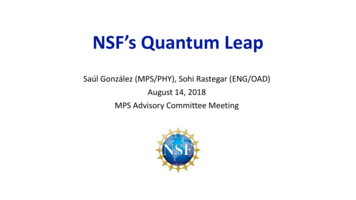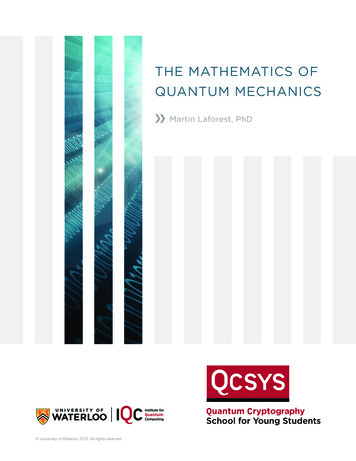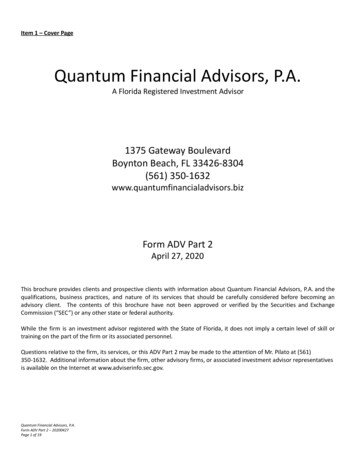
Transcription
I Don’t Understand Quantum PhysicsbyDouglas Ross FRSEmeritus Professor of Physics,University of Southamptoni
Contents1 Introduction - Understanding “understanding”.12 Some Classical Physics32.12.2Waves . . . . . . . . . . . . . . . . . . . . . . . . . . . . . . . . . . . . . . .32.1.1Interference and Diffraction . . . . . . . . . . . . . . . . . . . . . . .42.1.2Wavepackets . . . . . . . . . . . . . . . . . . . . . . . . . . . . . . . .52.1.3Travelling and Standing Waves . . . . . . . . . . . . . . . . . . . . .14Particles . . . . . . . . . . . . . . . . . . . . . . . . . . . . . . . . . . . . . .153 Experiments that Shook the World of Physics.223.1The Ultraviolet Catastrophe . . . . . . . . . . . . . . . . . . . . . . . . . . .223.2The Photoelectric Effect. . . . . . . . . . . . . . . . . . . . . . . . . . . . . .253.3Compton Scattering. . . . . . . . . . . . . . . . . . . . . . . . . . . . . . .273.4Bragg X-ray Diffraction . . . . . . . . . . . . . . . . . . . . . . . . . . . . .293.5The Davisson-Germer Experiment . . . . . . . . . . . . . . . . . . . . . . . .304 Wave-Particle Duality344.1Both a wave and a particle . . . . . . . . . . . . . . . . . . . . . . . . . . . .344.2Which Slit did the particle go through? . . . . . . . . . . . . . . . . . . . . .355 What is a Matter (de Broglie) Wave?376 Particles and Fields397 Heisenberg’s Uncertainty Principle418 Wavefunctions - Schrödinger’s Equation448.1Discrete Energy Levels . . . . . . . . . . . . . . . . . . . . . . . . . . . . . .448.1.1Particle in a Box (in one dimension) . . . . . . . . . . . . . . . . . .448.1.2Harmonic Oscillator . . . . . . . . . . . . . . . . . . . . . . . . . . .468.1.3The Hydrogen Atom . . . . . . . . . . . . . . . . . . . . . . . . . . .47ii
9 Quantum Tunnelling5110 Quantum States and Superposition5311 Two State Systems5511.1 Photon Polarization . . . . . . . . . . . . . . . . . . . . . . . . . . . . . . . .5511.2 Electron Spin . . . . . . . . . . . . . . . . . . . . . . . . . . . . . . . . . . .5712 Wavefunction Collapse6112.1 Decoherence . . . . . . . . . . . . . . . . . . . . . . . . . . . . . . . . . . . .13 Interpretations of Quantum Physics626513.1 Copenhagen Interpretation . . . . . . . . . . . . . . . . . . . . . . . . . . . .6513.2 Many Worlds Interpretation. . . . . . . . . . . . . . . . . . . . . . . . . . . .6514 Two Enigmatic “Thought Experiments”6714.1 Schrödinger’s Cat . . . . . . . . . . . . . . . . . . . . . . . . . . . . . . . . .6714.2 Einstein Rosen Podosky (EPR) Paradox - entanglement . . . . . . . . . . . .6915 Hidden Variables7216 Why is the Quantum World so Small?7717 Probabilistic Determinism7918 Is Quantum Theory Correct and Complete?81iii
AcknowledgmentsI am extremely grateful to Laurence Baron, Alexander Belyaev, Jean-Michel Jakobowicz, David Pugmire, Joe Stroud and Anthony Warshaw for reading earlier versions of thismanuscript and making a number of helpful suggestions for improving the clarity of the text.I have used many photos and drawings which I have found on the Internet, and in manycases the source of such photos and drawings is not clear. I have assumed that imageswhich appear on the Internet are in the public domain and do not need to be individuallyreferenced.January 2018iv
DedicationTo my wonderful wife, Jackie, who has given me tremendous support throughout my career.v
ForewordThis article is designed to describe (but not explain) the mysteries of Quantum Physics tothe interested lay person. I assume that the reader has studied and absorbed Physics andMathematics at normal High School level, but not at any further level. I have attemptednot to assume any Physics or Mathematics beyond this, without explaining it.I have not shied away from using Mathematics. Physics is a quantitative subject andrelies heavily on formulae to describe or predict the quantitative results of experiments. Toquote Richard Feynman [1] - “If you want to learn about Nature, to appreciate Nature, it isnecessary to understand the language that she speaks in.”Once again, no Mathematics is assumed beyond that normally studied in High School,but it is expected that the reader will be comfortable with the manipulation of symbols insimple algebraic equations and the application of some elementary trigonometry. The readerwho finds this too challenging should nevertheless be able to follow the general gist of thearticle - by taking the results quoted as correct and not being overly exercised by his (her)inability to comprehend the detail.Physics is a progressive subject and it is impossible to learn about Quantum Physicswithout a good grounding in classical physics, i.e. the physics that was understood bythe end of the nineteenth century, before the discovery of Quantum Theory. QuantumTheory essentially deals with the fact that everything which can transmit energy behavesboth as a particle and as a wave. This article therefore contains an introduction to someof the important properties of both waves and particles, which are necessarily used in thedescription of Quantum Physics.I have included a glossary of technical terms. I hope the reader will find it useful tobe able to refer to this whenever (s)he comes across a technical term which (s)he does notunderstand. The terms defined in the glossary appear in bold-face the first time they areused in the body of the text.I have also added an appendix of all the relevant mathematical formulae and equations.Do NOT read this appendix unless you have studied mathematics up to first year University level. It is included for completeness. If you feel that you would nevertheless like tosee a set of formulae which you will not understand and are confident that this will not putyou off or cause confusion, then take a look, but note that it is not necessary to read theseequations in order to be able to follow this article.The article is quite long and has to be read slowly and carefully. I felt that as far aspossible I should not skip steps and ask the reader to accept results quoted without any formof justification. It is also repetitive in parts – “repetito mater studorium est.”†I very much hope the reader gleans from this article some flavour of what must bedescribed as the most intriguing and enigmatic development in all of Natural Science.†repetition is the mother of all learning.vi
1Introduction - Understanding “understanding”.“I don’t understand Quantum Physics” the interested layman often asserts when (s)he meetsa theoretical physicist. The honest reply from the physicist is “Nor do I.”This seemingly facetious reply is indeed appropriate if the word “understand” is used inits usual context. What we usually mean is the ability to visualize something. If you wereto explain what a “waterfall” (for example) was to a person who had never seen one, thenprovided your explanation is sufficiently articulate, that person should be able to picturein his(her) mind what a waterfall actually looks like. When we think of sub-microscopicsystems (such as atoms), the temptation is to attempt to visualize them based on our visualexperience of the macroscopic world. Thus, since we can visualize the solar system in termsof the sun at the centre and a set of planets moving in elliptic orbits with the sun at onefocus, it is tempting to think of an atom which consists of a nucleus and electrons in thesame way, namely the nucleus at the centre and the electrons forming elliptical orbits aroundthe nucleus. Unfortunately this is erroneous and atoms do not lend themselves to such clearpictures in which the paths of the electrons can be precisely determined. We simply haveto get used to the idea that if we consider systems which are too small to be clearly seen(directly or indirectly) we need to abandon the luxury of being able to visualize such systemsin terms of our experience of macroscopic systems. Visualization is the usual, but not theunique way in which we can “conceptualize”. For example, by playing with two magnetswe can develop the concept of a force even though we cannot actually see what is pushingthe magnets apart or pulling them together. In this sense, we have an understanding ofa magnetic field. Similar effects can be observed with electrodes connected to the polesof a battery so that we can understand electric fields. However, there exists a type offorce called “degeneracy pressure” which is of purely quantum origin and has no classicalanalogue. This “degeneracy pressure” is the reason that a neutron star does not collapseunder its own gravity (unless the density of the neutron star exceeds a critical value knownas the Chandrasekhar limit [2]). Nevertheless, it cannot be “understood” within theframework of our everyday experiences.Traditionally, it was believed that the objective of Science was to be able to fully understand everything in Nature, by which we mean to be able to relate everything our everydayexperiences, in a way which is intelligible. This is regrettably not the case for modern physics,i.e. for the Quantum Physics. The objective of Theoretical Physics is reduced from this ambitious objective, to the development of a set of rules which enable us to calculate quantitieswhich can be experimentally measured. Quantum Theory generates an equation, whose solution yields (directly or indirectly) such physically measurable quantities. In (non-relativistic)Quantum Theory, this equation is was first written down by Erwin Schrödinger [3] in 1925(Schrödinger’s equation) and its solution can be used to calculate the optical spectrumof various atoms.11Only for the simple case of the hydrogen atom, can the Schrödinger equation be solved exactly. Formore complicated atoms, various approximate methods exist which generate these spectra up to a certainaccuracy.1
Such optical spectra can be observed in the laboratory and the successful comparisonof the observed spectra with those predicted from the solution to the Schrödinger equationtells us that Quantum Physics is consistent with Nature. We cannot, however, use thisto determine the exact (i.e. localized) positions of the electrons relative to the nucleus atany given time, simply because these exact positions do not exist in Quantum Physics. Anelectron does not possess the property of being located at a given precise point, rather ithas to be thought of as existing “everywhere”, with a high probability of being found at acertain location and a very small probability of being found far away from that location. Itmay be really strange to assert that an electron does not actually possess a single (localized)position, but we have to live with this strange idea if we accept that Quantum Physicsdescribes Nature correctly. The absence of predictions of the positions of the electrons doesnot indicate a failing of the theory, because it allows physicists to calculate quantities whichcan be experimentally measured - and so far these calculations have always agreed with theexperimental measurements. It is this agreement that promotes Quantum Theory to thestatus of “a correct theory” despite its failure to allow us to “understand” what is goingon inside an atom. Thus we theoretical physicists are not simply being awkward when wesay that we “don’t understand Quantum Physics”. We mean that whereas it gives us a setof working rules that enable us to calculate measurable quantities, it does not help us tounderstand what is going on inside an atom. We have to accept the rather uncomfortableidea that objects which are too small to be seen, cannot be described in terms of the usualconcepts, with which we are familiar.2
Figure 1: A pure sine wave. The wavelength is the distance between two adjacent peaks(or troughs). The number of peaks (or troughs) passing a given point per second is calledthe “frequency”. The wave velocity is the wavelength multiplied by the frequency.2Some Classical PhysicsBefore we can proceed to discuss Quantum Physics we need to understand a few thingsabout classical physics. This should all be conceptually straightforward, since not only canwe visualize the phenomena described, but we can set up experiments using macroscopicobjects and observe them directly.2.1WavesA wave is a quantity which oscillates between a maximum and minimum and travels inspace. The number of times it reaches a maximum per second (at a fixed point) is calledthe “frequency” and the instantaneous distance between two maxima is called the “wavelength”. The maximum value of the oscillating quantity is called the “amplitude”. Thisis demonstrated in Fig. 1.The quantity which travels in this way is known as a “disturbance”. Precisely whatthis disturbance is depends on the wave. For ocean waves it is the surface of the water.For sound waves it is the fluctuation in pressure, for light (and all other electromagneticradiation such as microwaves, X-rays etc.) it is an electric field and a magnetic field whichare perpendicular to each other and also perpendicular to the direction of the wave. Thesimplest waves can be generated by taking a long length of string under tension (such as awashing line) and shaking one end, so that it oscillates with a constant frequency.3
Figure 2: Interference of light emerging through two narrow slits. The light emergesfrom each slit as though the slits were the sources of the light. The light from the two slitstravel a slightly different distance to a given point on the screen. If this distance is a wholenumber of wavelengths, the peaks and troughs coincide and we get a maximum, whereashalf-way between these maxima the peaks from one slit coincide with the troughs for theother so that the wave motion from the two slits cancels out and we get a minimum. Thisis know as the “Young’s slits” experiment after Thomas Young [4] who first performedthe experiment in 1801.2.1.1Interference and DiffractionSuppose a wave-front is incident on two slits which are close together. Waves are emittedfrom each of the two slits, as shown in Fig. 2.If the resultant wave is observed on a screen at a point half-way between the two slitsthen the wave from each slit will have travelled the same distance and they will thereforebe “in phase” i.e. they will have maxima together and minima together. This means thatthe total disturbance will be the sum of the two disturbances and we have what is called an“interference maximum”. On the other hand, if the resultant wave is observed slightly awayfrom the mid-point between the slits then the wave from one of the slits travels further thanthe wave from the other, and the waves from the two slits will no longer be in phase so thatthe resultant disturbance will be a wave whose amplitude is smaller than the sum of thetwo amplitudes. In the case where the extra distance travelled by one of the waves is half awavelength the waves will cancel out exactly, leading to a minimum. This is demonstrated4
in Fig. 3.Even further away from the mid-point the path difference between the waves from thetwo slits is again a whole number of wavelengths and the disturbances are again in phase– and so on. This is shown in Fig. 4. The result is an interference pattern consisting ofseries of light and dark fringes as shown on the right of Fig. 4.We can do this experiment by shining a laser pen-torch on the surface of a DVD. TheDVD consists of a large number of closely ruled grooves and the laser pen-torch produceslight of a single wavelength. If the reflected light is observed on a screen whose plane isperpendicular to the DVD, then we see series of spots corresponding to the maxima in whichlight reflected from adjacent grooves on the DVD are exactly an integer number (i.e. wholenumber) of wavelengths apart so that the waves from all the grooves are in-phase and addup. The experimental setup is shown in Fig. 5. The rainbow which one can see when youlook at a DVD and move it around arises because these maxima occur at slightly differentangles for different wavelengths so that white light is dispersed, generating the rainbow.Something similar happens if we illuminate a small object (such as a pin) with monochromatic (i.e. single wavelength) light. A set of closely packed fringes can be seen either side ofthe object, owing to interference between light waves from the two sides of the object. This isactually called “diffraction” (but I have never seen an adequate definition of “interference”and “diffraction” which distinguishes between the two).An example is shown in Fig. 6, which shows the diffraction pattern of a pin-head illuminated with monochromatic (red) light. There is interference between the wave that passesaround the object in one direction with the wave that passes around the object in the otherdirection, leading to fringes whose maxima and minima correspond to directions in whichthese two waves are in phase or out of phase. The path difference between these two wavesis proportional to the size of the object, so that the separation of the fringes is proportionalto the ratio of the wavelength of the light to the object size. If the object is much largerthan the wavelength of the light used, then we still get a sharp image of the object, togetherwith closely packed diffraction fringes. On the other hand, if we look at even smaller objectswhich are of the order of magnitude of the wavelength of the light, the fringes become moreand more widely separated and eventually we just see the fringes but no sharp image of theobject.2.1.2WavepacketsA pure wave with a single wavelength/frequency oscillates for ever - the wave is infinitelylong. In practice a wave only exists for a finite time interval. In the case of the sound froman object landing on the floor this could be about 1/20th of a second.The wave would look something like the wave shown in Fig. 7, in which we have a waveof some frequency, f0 , with an amplitude which grows and then shrinks again. The totallength of the wavepacket is the distance over which the amplitude grows plus the distanceover which it shrinks. Thus, whereas a classical point-particle is totally localized, i.e. it5
wave 1wave 2Total Wavewave 1wave 2Total Wavewave 1wave 2Total WaveFigure 3: The left panel shows the lower two waves travelling the same distance andtherefore being in phase so that the resultant disturbance is a wave with double theamplitude – an interference maximum. The centre panel, shows the lower wave travellinga extra distance of one quarter of a wavelength relative to the upper wave and theresultant disturbance is a wave with a reduced amplitude. In the right panel the lowerwave travels an extra distance of one half of a wavelength so that the two disturbances areexactly out of phase - one has a maximum at the point where the other has a minimumand vice versa so that the resultant disturbance is zero and we have an interferenceminimum.6
Figure 4: The double slit experiment (a). The interference from the light from the twoslits leads to a set of fringes on the screen (b)Figure 5: Using a DVD as a diffraction grating with a laser pen-torch held on a stand,a CD or DVD and a vertical screen, spots corresponding to interference maxima appearon the screen.7
Figure 6: The diffraction pattern obtained from illuminating a pin-head with monochromatic (red) light. The diffraction pattern arises from interference between light waveswhich go around the pin in one direction and those that go around the pin in the otherdirection. For light emerging at different angles these two waves will have different phasedifferences because they travel different distances. Maxima are found when the difference in distance travelled by the two waves is a whole number of wavelengths so thatthe waves are in phase and add up. Because the width of the pin is very much largerthan the wavelength of the light used to illuminate it, the fringes are closely packed andthere is a reasonably sharp image of the pin at the centre.8
Figure 7: An example of a wavepacket representing a wave that lasts for a finite time.The amplitude begins very small and then grows to a maximum and then shrinks again.has a well-defined exact position in space, a wavepacket is spread over a finite distance andtherefore cannot be said to have a definite (i.e. localized) position. The wavepacket existseverywhere although the amplitude has a maximum at a specific position (at a given time).The amplitude decreases as one moves away from that specific position and is negligiblysmall far away from it. It is a mathematical fact that such a wavepacket is actually the sumof many pure frequency waves as shown in Fig. 8 with different amplitudes and frequenciesslightly different from f0 . The largest amplitude is the wave with frequency, f0 but there areother frequencies ranging from a little below, i.e. f0 21 f , to a little above, i.e. f0 12 f .The range of frequencies required to construct the wavepacket is f . Waves with differentfrequencies and amplitudes for which, when the disturbances of the individual waves addedtogether, generate a total disturbance given by the wavepacket of Fig. 7.In Fig. 9 we show a bar-chart of the amplitudes of the pure waves against frequency (itis easy to write a simple computer program which verifies that this works.) So, contraryto common belief, any wave which lasts a finite time, t, is never a pure single-frequency(monochromatic) wave with frequency f0 , but a superposition of waves with the largestamplitude for frequency f0 , but with waves with frequencies below and above f0 , albeit withsmaller amplitudes. This is extremely important. It means that if we hear a short soundsuch as an object knocking against another object or a balloon popping, or see a very shortflash of light, it is meaningless to ask the question “What was the frequency of that noise,or that flash”, because a short wavepacket does not possess a well-defined (exact) frequency- it is a superposition of many different frequencies.9
Figure 8: Waves with different frequencies and amplitudes for which, when the disturbances of the individual waves added together, generate a total disturbance given by thewavepacket of Fig. 7.10
Figure 9: A bar-chart showing the frequencies and amplitudes which constitute thewavepacket of Fig. 711
f 5 HzAmplitude t 1 sec.1012141618frequency (Hz)202200.20.4(a)0.6 0.81time (secs)1.21.41.61.41.6(b) t 0.5 sec.Amplitude f 10 Hz1012141618frequency (Hz)20022(c)0.20.40.6 0.81time (secs)1.2(d)Figure 10: (a): the spectrum of frequencies with range of 5 Hz; (b): The resultingwavepacket with time range of 1 sec. (c): the spectrum of frequencies with range of 10Hz (d): The resulting wavepacket with time range of 0.5 sec. Note that we have chosento plot the disturbance at a given point as a function of time. We could have chosento plot the spatial distribution of the disturbance at a given instant (same time). Theshape of the graphs on the right would have been exactly the same. The graphs on theleft would have been replaced by a distribution in wavelengths rather than frequencies.The lower graphs would have a wider range of wavelengths than the upper graphs.12
In Fig. 10, we show two more such bar-charts and the wavepackets that are producedwhen we add the waves with the amplitudes and frequencies shown in the bar-charts. Inthis case, we show the relevant numbers. In the upper figure the frequency ranges fromabout 13.5 to 18.5 Hertz (abbreviated to ‘Hz’, meaning cycles per second) and the resultingwavepacket has a width (time interval) of around 1 second. In the lower figure, the range offrequencies is significantly larger - from about 10 to 20 Hz, but the wavepacket is narrower,with a width of around 0.5 seconds. In both cases, if we multiply the range of frequenciesby the width of the wavepacket we get approximately the same result (around 5). This isa result which can be derived from the mathematical properties of wavepackets and tells usthat the width of the wavepacket is inversely proportional to the range of frequencies whichare used to construct that particular wavepacket. This result is the basis of the Heisenberguncertainty principle. We will see later that the width of the wavepacket is proportionalto the uncertainty in the position of a particle and the range of frequencies is proportionalto the uncertainty in its momentum.13
t 1t 2t 3Figure 11: A travelling wave at three different times showing how the peaks and troughspropagate through space as time advances.2.1.3Travelling and Standing WavesA travelling wave, such as the wave on the surface of the sea, advances as time evolves.For a single wavelength wave, if we take a snapshot of the disturbance we see a disturbancewhich oscillates in space with peaks and troughs. At a later time a particular peak hasmoved on (either to the right or to the left depending on the direction of the wave). This isdemonstrated in Fig. 11 where we show for three such snapshots at different times and notethat a particular peak (or trough) advances with time.The other type of wave is called a “standing wave”. This occurs if there is somerestriction on the disturbance at the ends. An example is a violin string for which thedisturbance of the string is zero at the bridge of the violin and also zero at the point on theneck where a finger presses on the string so that there is no displacement. In this case thewave does not propagate, but remains with the same shape with an amplitude that oscillateswith time as shown in Fig. 12. For such waves only certain wavelengths are allowed. Thereason for this is that the disturbance vanishes at two points. The allowed wavelengths arethose for which the disturbance can be zero at both these points - i.e. the distance betweenthese two points must be a whole number of half-wavelengths (see Fig. 13). This in turnmeans that the longest wavelength, λ1 , that a standing wave can have is 2L, where L is thedistance between the two points at which the disturbance is constrained to be zero. Such awave only has zeros at the ends (x 0 and x L).In the case of a violin string, the fact that this is a specific wavelength means that the14
t 1t 2t 3xx LFigure 12: The time development of a standing wave. This wave does not propagatethrough space but simply oscillates, maintaining the constraint that the disturbance iszero at the end points, x 0 and x L.string vibrates with a specific frequency producing a sound with a given pitch. The nextpossible wavelength, λ2 , is L, which has zeros at the ends and also a zero in the middle.After that we have λ3 32 L which has zeros at the ends and two points between the endswhere the disturbance is also zero. These three cases are demonstrated in Fig. 13. In general,a standing wave in which the disturbance at x 0 and x L is zero can have a wavelengthλn , given byλn 2.22Lwhere n is a positive integer, (i.e a whole number e.g. 1,2,3,4 . . . . . . ).n(2.1)ParticlesIn classical physics particles behave like tiny billiard balls (so tiny that they may be considered to be points). Their motion is determined by Newton’s three laws of motion [5].A moving particle of mass m moving with velocity v (assumed to be very small comparedwith the speed of light – so that relativistic effects may be neglected) has a kinetic energyT 21 mv 2 and momentum p mv. p and v are written in bold letters because they represent “vectors” i.e. they have direction as well as magnitude or alternatively they have threecomponents - one for each direction in space. It is insufficient to specify the speed, v, ofa particle in order to describe its motion. We also need to know the direction in which it ismoving. In an elastic collision (no loss of energy into heat or sound) the total kinetic energy15
λ 2Lλ Lλ 2L/3Figure 13: The longest (λ 2L), next longest (λ L) and third longest (λ 23 L)wavelength for standing waves in which the displacement is constrained to be zero atx 0 and at x L.16
Figure 14: When a ball of mass m collides head-on with a stationary ball with the samemass, conservation of momentum tells us that the target ball then moves with the initialvelocity of the incident ball and the incident ball becomes stationary.and the three components of momentum are conserved. For a given scattering between twoparticles with given masses and initial velocities these conservation laws are sufficient toderive a unique relation between the final speeds of the two particles and their scatteringangles (i.e. the angle between the initial and final directions of motion).An example is shown in Fig. 14 in which a particle (1) with initial velocity u1 collideswith an initially stationary particle (2). The final speeds v1 and v2 and the angles of theparticles after the collision are related to each other. As any good billiards player knows,the scattering angle of the incident billiard ball is determined by the offset of the centres. Ifthe projectile billiard ball had a velocity whose direction is through the centre of the targetbilliard ball, then after the collision the two billiard balls will continue to move in the samedirection, but if the billiard balls are not concentric then the balls will scatter at an angledetermined exactly by the offset of the two centres. Thus an expert billiards player can17
.vvθθ.Figure 15: For a ball bounced of a hard surface for which there is no loss of energy Theinitial speed is the same as the final speed (because the kinetic energy after the bounceis the same as the kinetic energy before) and the angle the trajectory of the ball makeswith the surface is also conserved because the component of momentum tangential tothe surface is conserved.shoot the projectile ball in such a way that (s)he can precisely predict the final velocities(speeds and directions) of the two billiard balls. In particular, for the ball bounced off ahard surface (no energy loss), the conservation of momentum and kinetic energy is sufficientto tell us that the angle of ref
Physics is a progressive subject and it is impossible to learn about Quantum Physics without a good grounding in classical physics, i.e. the physics that was understood by the end of the nineteenth century, before the discovery of Quantum Theory. Quantum Theory essentially deals with t










